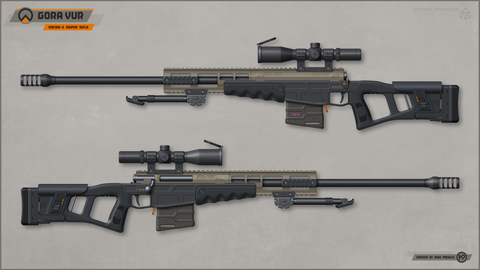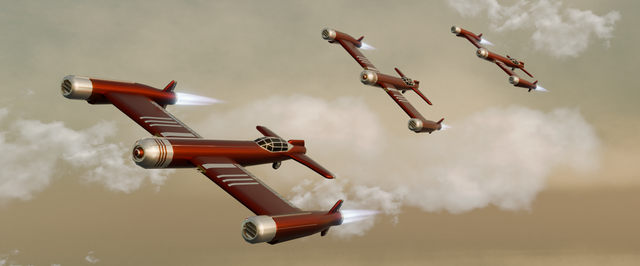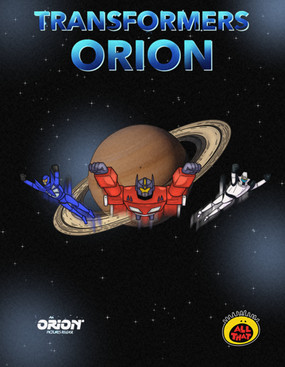HOME | DD
 RaishaGS — Technology File - UNTC-13B Epsilon AAT
by-nc-nd
RaishaGS — Technology File - UNTC-13B Epsilon AAT
by-nc-nd

Published: 2021-05-31 12:08:07 +0000 UTC; Views: 29751; Favourites: 285; Downloads: 34
Redirect to original
Description
ACCESSSING FILE: G-05
Technology File - UNTC-13B Epsilon Aerial Assault Transport
Written by Kiev Yarkov,
UNTD Lab 1 Chief Scientist
Serving as the main mode of transport for UNITE's Enforcer corps, the UNTC-47 Epsilon is an advanced transport jet capable of getting Enforcers squads in and out of an engagement zone in record time.
The development of the Epsilon could be traced back to the 60's as tensions between the United States and the USSR during the Cold War were slowly reaching a boiling point. This period would mark a technological arms race between both sides as they continued to break new grounds in the field of weapons developments. This also meant that both the United States and Soviet Russia were willing to do just about anything to get their hands on the opposing side’s intel.
As the Cold War progressed, the CIA enacted a number of covert operations revolving around the deployment of Special Forces right into the heart of Russia in the hopes of acquiring vital intel, and/or eliminating key Soviet targets. However, infiltrating the country was no easy feat as conventional transport aircraft were easily detected by long ranged sensors, and those small and fast enough to evade detection by ground defenses did not have the capacity needed to carry large squadrons and their equipment into an engagement zone. As such, priority was placed on the development of aircraft capable of rapid infiltration and exfiltration.
In 1956 the CIA would approach French based company, Lauren Machina Industries (LMI), which at the time was one of the leading companies in aerospace, electronics, and land systems for the development of this aircraft. From there, Project Brionac would commence and by November of that same year, the first prototype was completed and would undergo rigorous combat and utility evaluations.
The aircraft, known as the BX-3447E demonstrator, sported a wide, forward-swept wing design reminiscent of the Gruman X-29. Built into the wing structures were two state of the art RJE-83395 ramjet engines which were capable of thrust vectoring, allowing the aircraft to reach Mach-3 whilst also giving it VTOL capabilities, a trait which was greatly desired by the US Government for its intended operations. The entire aircraft was also covered in an experimental optical camouflage system which made the aircraft invisible to both enemy radar and the naked eye; an ability which also greatly benefitted its infiltration role. However its high energy usage meant that it was only activated when approaching an engagement zone.
By early 1957, trials for the aircraft were completed and LMI was given the greenlight to begin production of the LMI-XF33 R-Delta, named because of its reversed delta wing design. In total, four R-Deltas were constructed with the first rolling off the production line in mid 1957, and would begin its service under the CIA covert operations team, 10 Sparrows. During this period, the aircraft would fly numerous successful missions over Ukraine, North Korea, and Vietnam. While it was exceedingly fast and maneuverable, its experimental VTOL engines (a concept which would not be perfected until 1997) made the aircraft extremely unstable during vertical takeoff and landing, requiring extremely talented pilots in order to perform quick landings and takeoff during missions; often in areas with poor visibility conditions and/or with limited space.
The fall of the Soviet Union in 1991 marked the end of the Cold War, and with that, a change in political landscape; one which no longer saw such a role-specific aircraft as a necessary asset. All four R-Deltas were retired by the following year with three of them being scrapped and the fourth remaining under LMI's care till this day.
Despite its retirement from service, the legacy of the Delta-R would not end just like that. Fast forward to the present day and the world face a new threat in the form of the Shadow Beasts. Under the leadership of Director Allana Ares, the newly formed UNITE prepares to lead a country-wide counteroffensive against this new foe. In order to maintain secrecy of UNITE operations, and in turn, the existence of the Shadow Beasts, protocol dictated that during an EXA incursion, UNITE forces should always be the first on the scene in order to survey the situation and determine if additional reinforcements are needed.
Initially this role was filled by the UNTC-12 Pegasus which, as you recall, was also capable of providing rapid deployment and support for the UNTA-X41 Spectra Artillery . However, UNITE's high command deemed the aircraft's speed as inadequate for meeting the Enforcer Corps' primary role of first response and assessment.
Hot off the development of their previous success, the top brass of LMI wondered if they could push their VTOL technology even further. They were already developing a larger, more advanced variable thrust engine, but for this to happen, they would need an aircraft suitable for housing it.
With the lessons learnt from the R-Delta, LMI set to work on a successor aircraft that would embody all of its abilities, and much more. Sticking to its roots, the next generation assault transport, dubbed the Epsilon, would retain its recognizable reverse-delta wing design and sharp elongated fuselage. One of the key changes to the aircraft was the removal of its optical camouflage, instead replaced with a more contemporary usage of radar absorption material and coatings.
Unlike the R-Delta, the Epsilon was a full-fledged assault transport, and not one to be underestimated. Its new engines gave the aircraft much greater power; allowing it to lift not just its occupants but a slew of additional weapons and countermeasures. Hidden within the aircraft’s lower fuselage are two internal bays which house its main weapons: a turreted gatling gun, and 12 missiles. The missiles which are located in the central weapons bay are split between air-to-air and air-to-surface; with the amount configurable to suit the mission scenario. The frontal weapons bay houses the 20mm gatling gun turret capable of automated or manual targeting. Much like the Pegasus, this main gun would often be used to strafe an engagement zone and provide covering fire for troops during an insertion or exfiltration operation.
Above the weapons bay is where all the action takes place. The Epsilon’s upper fuselage is divided into three sections: the cockpit at the front, a briefing room/mini armory at the middle, and a troop housing area at the rear. The aircraft is normally crew by four individuals: a pilot, a co-pilot (who can also serve as the gunner for the aircraft's turret), and two radar technicians. The Epsilon is also capable of ferrying a total of up to 12 soldiers and their gear anywhere across the world in under a few hours. Personnel enter/exit through a large door at the rear similar to that of the Lockheed C-130 Hercules or the Boeing CH-47 Chinook. While not intended to transport large cargo, the Epsilon has the capacity to also shuttle small vehicles to their destination if needed.
As an aircraft intended for long range operations, the Epsilon is equipped with many systems required for its role such as long range communications, radar jamming suite, and global positioning systems, just to name a few. Thanks to the radar absorption material covered across the aircraft, the Epsilon is practically invisible to enemy radar. In the event it is pursued by enemy aircraft, or long range missiles, the aircraft has both electronic countermeasures and countermeasure flares at its disposal. However these rarely if ever have to be used as the Epsilon is equipped with two RXB-3400 cyclone drive engines. These engines, which were derived from the Hermes drone, allow the aircraft to switch between normal flight and VTOL mode and can generate a top speed of Mach 3; more than sufficient for the aircraft to evade most anti-air missiles.
With a much more powerful engine came the issue of stability, a fact which plagued the R-Delta. Thankfully the Epsilon's advanced on board computer systems is capable of making quick on the fly adjustments to the pilot's controls, taking into account factors such as wind, and weather conditions. This means that unlike its predecessor, the Epsilon does not require an ace pilot at its helm, and is a considerably easier aircraft to fly.
Overall, the Epsilon is one of the most iconic aircraft in UNITE’s arsenal and is the culmination of years of trials, and technological advancements in the field of aeronautics. There is no location too far or too hostile that this Valkyrie of the sky wont go, and many pilots have testified to the reliability and versatility it provides. Whether you are a UNITE Agent, Trooper, or Enforcer, the sound of an Epsilon’s engines often signals the arrival of hope on the battlefield.
(Pictured above: an isometric view of the Epsilon, and a side view against an average sized adult male and Magilily Neu.)
- End of Report -
-----------------------------------------------------------------------------------------------------
-----------------------------------------------------------
Been a while since I did one of these. As you can tell, this is an updated design of the UNTE-01 Epsilon Interceptor I did a very long time ago for ironshadow's webcomic, now repurposed for The Neu House. Most of the general aesthetics of the aircraft have mostly remained the same. However the updated design no longer features the weapon hardpoints, and portable ion cannon under the aircraft.
Man, that old design did not age well. In fact, I have no idea why I called it an 'Interceptor' when in reality it was a transport aircraft similar its current iteration. Don't worry though, some of those design aspects might return for a seperate aircraft in the future.
twitter.com/Raisha_GS
www.instagram.com/raisha.gs/
www.facebook.com/RaishaGS
Magilily Neu, In the Neu House © BRSstarJV
Lynn Loud Sr, The Loud House © Nickelodeon
Related content
Comments: 28

👍: 0 ⏩: 0

👍: 1 ⏩: 1

👍: 1 ⏩: 1

👍: 1 ⏩: 1

👍: 0 ⏩: 1

👍: 0 ⏩: 0

👍: 2 ⏩: 1

👍: 1 ⏩: 0

👍: 1 ⏩: 1

👍: 0 ⏩: 0

👍: 1 ⏩: 1

👍: 1 ⏩: 1

👍: 1 ⏩: 1

👍: 0 ⏩: 1

👍: 1 ⏩: 1

👍: 0 ⏩: 1

👍: 0 ⏩: 0

👍: 1 ⏩: 1

👍: 0 ⏩: 0

👍: 1 ⏩: 1

👍: 1 ⏩: 1

👍: 1 ⏩: 0

👍: 2 ⏩: 1

👍: 1 ⏩: 1

👍: 1 ⏩: 0

👍: 2 ⏩: 1

👍: 0 ⏩: 0


























